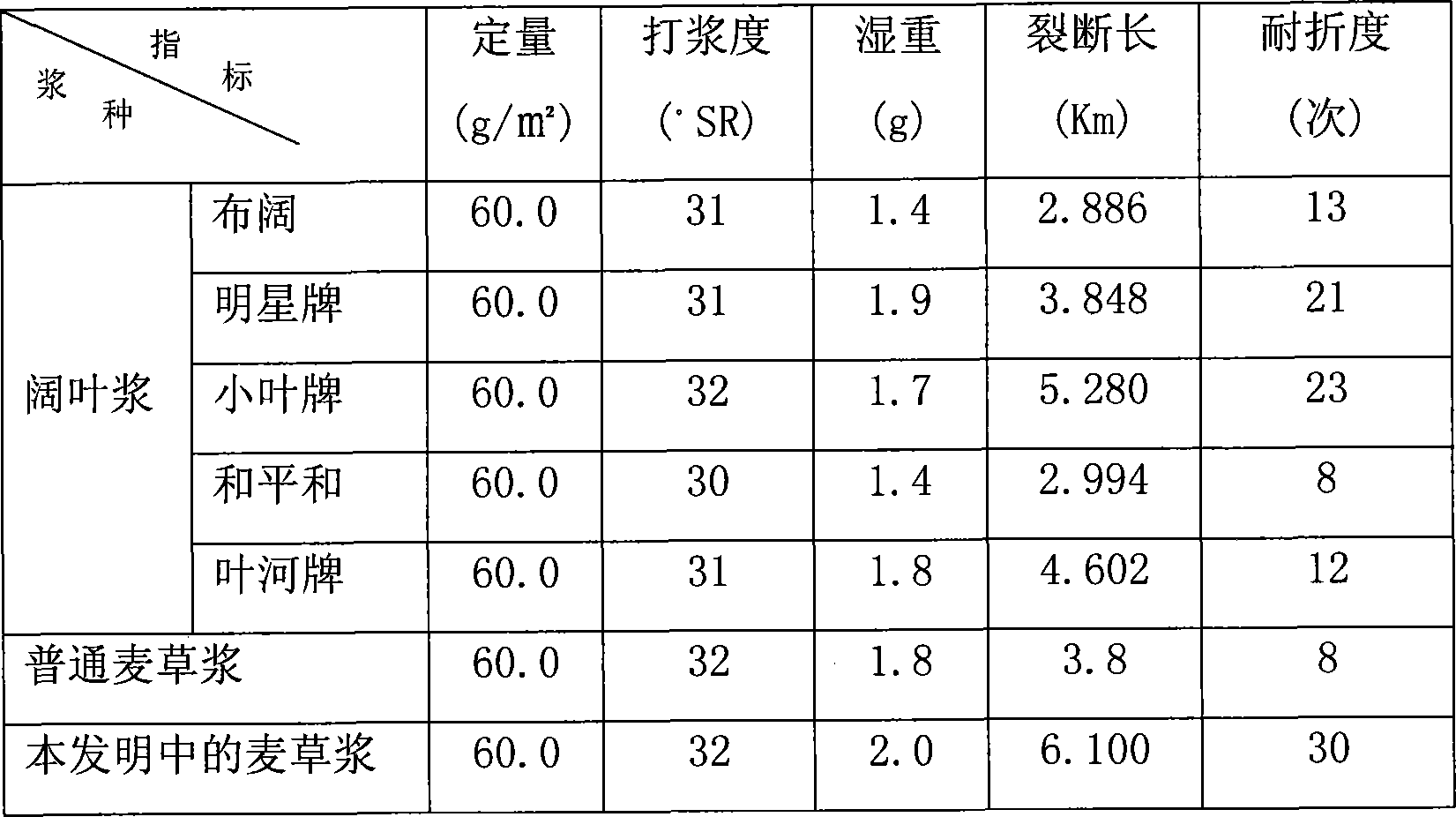Prepared bleach chemical pulp using grass kind plant as raw material and preparation method thereof
A technology of plant raw materials and chemical pulp, applied in chemical/chemical mechanical pulp, non-woody plant/crop pulp, pulping with inorganic alkali, etc., can solve problems such as high carbohydrate content, difficult recycling, and large energy consumption , to achieve the effect of low price, alleviating the lack of wood resources and excellent performance
- Summary
- Abstract
- Description
- Claims
- Application Information
AI Technical Summary
Problems solved by technology
Method used
Image
Examples
Embodiment 1
[0047] The wheat straw is cooked by the ammonium sulfite method, specifically 4% sodium hydroxide solution is used for pre-impregnation, the amount of ammonium sulfite added is 10% of the dry raw material, the liquid ratio is 1:4, and the temperature is raised to 110°C for the first time , keep warm at this temperature for 20 minutes, then let off steam for 20-30 minutes, heat up for 30 minutes for the second time to a temperature of 168°C, and keep warm for 90 minutes. The cooked pulp is washed and thickened to obtain an unbleached chemical pulp with a hardness of 20, equivalent to a Kappa value of 31, a degree of knockdown of 22°SR, and a concentration of 10%, and then the pulp is heated to 70°C by a screw conveyor. Transported to the medium-consistency slurry pipe. The pulp is subjected to tempering treatment in the medium-consistency stock pipe to remove the air in the pulp to make it fluidized, and then it is transported to the oxygen bleaching reaction tower by a centrif...
Embodiment 2
[0049] The rice straw is cooked by the caustic soda-anthraquinone method. Specifically, the amount of caustic soda added is 10% of the dry raw material, the anthraquinone added is 0.7% of the dry raw material, the liquid ratio is 1:4, and the temperature is raised to 110 for the first time. ℃, keep warm at this temperature for 20 minutes, let off steam for 20-30 minutes, heat up for the second time for 30 minutes to a temperature of 168 ℃, and keep warm for 90 minutes. The cooked pulp is washed and thickened to obtain an unbleached chemical pulp with a hardness of 22, which is equivalent to a Kappa value of 36, a beating degree of 24°SR, and a concentration of 12%. Then the pulp is heated to 60°C and passed through the volumetric formula. The thick slurry is pumped to the oxygen bleaching reaction tower. Before entering the reaction tower, the slurry is mixed with 40kg of added oxygen per ton of slurry and 2% sodium hydroxide of dry pulp weight in the pipeline, and steam is fe...
Embodiment 3
[0051]The wheat straw and reed are mixed according to 1:1 and then cooked by the ammonium sulfite method. Specifically, they are mixed and impregnated with 4% sodium hydroxide solution to the absolute dry raw material, then sent to the steaming ball, and 11.5% of the absolute dry raw material is added. Ammonium sulfate, liquid ratio 1:3, heat up to 100°C for the first time, keep warm at this temperature for 20 minutes, let off steam for 20-30 minutes, heat up for 30 minutes for the second time to 165°C, keep warm for 60 minutes minute. The cooked pulp is first squeezed through a single-screw squeezer, and then washed to obtain an unbleached chemical pulp with a hardness of 18, which is equivalent to a Kappa value of 27, a percussion degree of 26°SR, and a concentration of 10%. The slurry is heated to 76°C and transported to the oxygen bleaching reaction tower through a volumetric thick slurry pump. Before entering the reaction tower, the slurry is mixed with 30kg of added oxy...
PUM
| Property | Measurement | Unit |
|---|---|---|
| Knocking degree | aaaaa | aaaaa |
| Knocking degree | aaaaa | aaaaa |
| Knocking degree | aaaaa | aaaaa |
Abstract
Description
Claims
Application Information
 Login to View More
Login to View More - R&D
- Intellectual Property
- Life Sciences
- Materials
- Tech Scout
- Unparalleled Data Quality
- Higher Quality Content
- 60% Fewer Hallucinations
Browse by: Latest US Patents, China's latest patents, Technical Efficacy Thesaurus, Application Domain, Technology Topic, Popular Technical Reports.
© 2025 PatSnap. All rights reserved.Legal|Privacy policy|Modern Slavery Act Transparency Statement|Sitemap|About US| Contact US: help@patsnap.com

